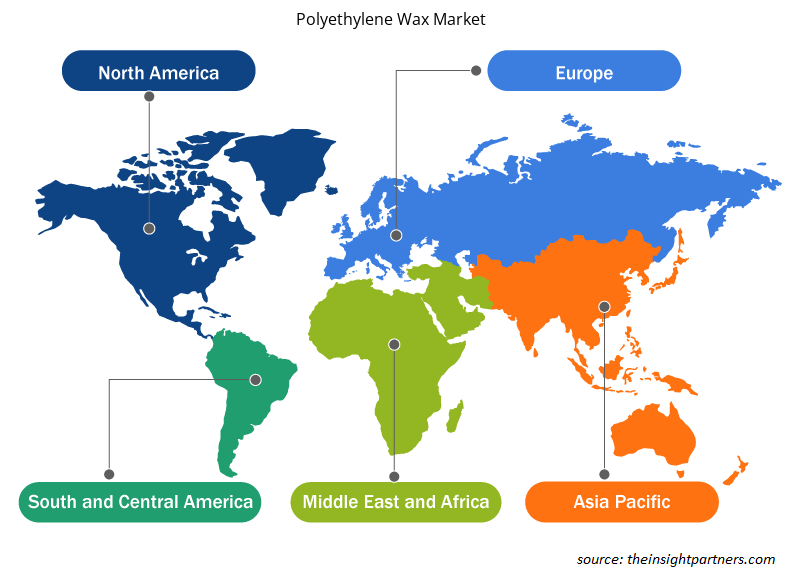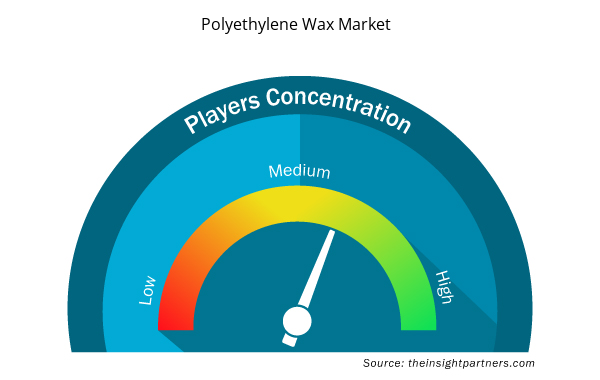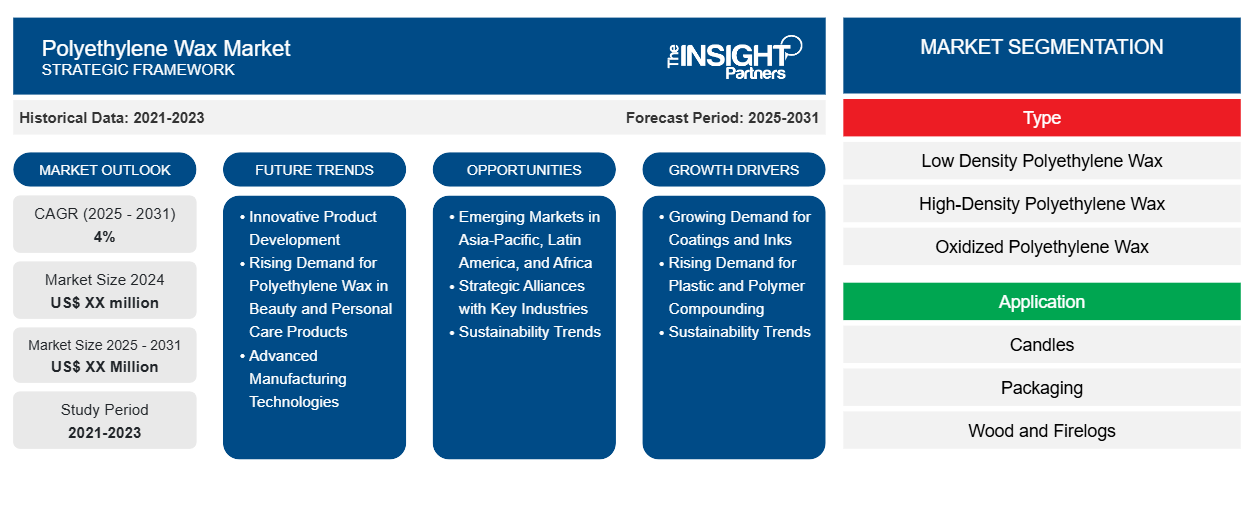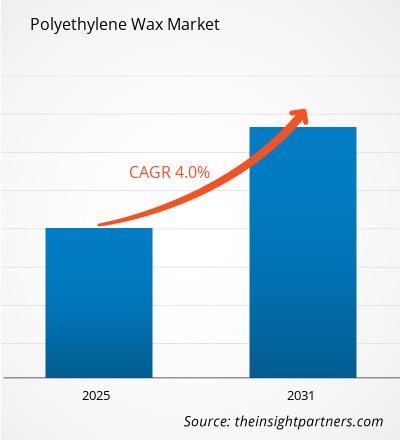Der Markt für Polyethylenwachs wird voraussichtlich von 2023 bis 2031 eine durchschnittliche jährliche Wachstumsrate (CAGR) von 4 % verzeichnen, wobei die Marktgröße von XX Millionen US-Dollar im Jahr 2023 auf XX Millionen US-Dollar im Jahr 2031 anwachsen wird.
Der Polyethylenwachs-Marktbericht ist nach Typ segmentiert (Polyethylenwachs niedriger Dichte, Polyethylenwachs hoher Dichte, oxidiertes Polyethylenwachs und andere). Der Markt ist nach Anwendung segmentiert (Kerzen, Verpackungen, Holz und Brennholz, Kunststoffzusätze und Schmiermittel, Klebstoffe und Beschichtungen, Kosmetika und andere). Die globale Analyse ist weiter auf regionaler Ebene und nach wichtigen Ländern aufgeschlüsselt. Die Marktgröße und -prognose auf globaler, regionaler und Länderebene für alle wichtigen Marktsegmente werden im Rahmen des Berichts abgedeckt. Der Bericht bietet den Wert in USD für die oben genannte Analyse, Segmente, Regionen und Länder. Der Bericht deckt Markttrends sowie Marktdynamiken wie Treiber, Beschränkungen und wichtige Chancen ab. Der Bericht deckt auch Branchenlandschaft und Wettbewerbsanalyse ab, einschließlich Marktkonzentration, Heatmap-Analyse, prominenten Akteuren und jüngsten Entwicklungen auf dem Markt.
Zweck des Berichts
Der Bericht Polyethylenwachsmarkt von The Insight Partners zielt darauf ab, die gegenwärtige Landschaft und das zukünftige Wachstum sowie die wichtigsten treibenden Faktoren, Herausforderungen und Chancen zu beschreiben. Dies wird verschiedenen Geschäftspartnern Einblicke geben, wie zum Beispiel:
- Technologieanbieter/-hersteller: Um die sich entwickelnde Marktdynamik zu verstehen und die potenziellen Wachstumschancen zu kennen, damit sie fundierte strategische Entscheidungen treffen können.
- Investoren: Durchführung einer umfassenden Trendanalyse hinsichtlich der Marktwachstumsrate, der finanziellen Marktprognosen und der Chancen entlang der Wertschöpfungskette.
- Regulierungsbehörden: Zur Regulierung von Richtlinien und Überwachungsaktivitäten auf dem Markt mit dem Ziel, Missbrauch zu minimieren, das Vertrauen der Anleger zu bewahren und die Integrität und Stabilität des Marktes aufrechtzuerhalten.
Polyethylenwachs Marktsegmentierung
Typ
- Polyethylenwachs mit niedriger Dichte
- Polyethylen hoher Dichte Wachs
- Oxidiertes Polyethylenwachs
Anwendung
- Kerzen
- Verpackung
- Holz und Brennholz
- Kunststoffadditive und Schmiermittel
- Klebstoffe und Beschichtungen
- Kosmetika
Passen Sie diesen Bericht Ihren Anforderungen an
Sie erhalten kostenlos individuelle Anpassungen an jedem Bericht, einschließlich Teilen dieses Berichts oder einer Analyse auf Länderebene, eines Excel-Datenpakets sowie tolle Angebote und Rabatte für Start-ups und Universitäten.
- Holen Sie sich die wichtigsten Markttrends aus diesem Bericht.Dieses KOSTENLOSE Beispiel umfasst eine Datenanalyse von Markttrends bis hin zu Schätzungen und Prognosen.
Wachstumstreiber auf dem Polyethylenwachsmarkt
- Wachsende Nachfrage nach Beschichtungen und Tinten: Die globale Beschichtungs- und Tintenindustrie ist einer der Hauptfaktoren, die das Wachstum des globalen Polyethylenwachsmarktes beeinflussen. Seine Eigenschaften als Zusatzstoff, der unter anderem Glanz, Härte und Kratzfestigkeit verbessert, haben Polyethylenwachs zu einem gängigen Bestandteil in Farben, Beschichtungen und Tinten gemacht. Der Anstieg der Nachfrage nach Beschichtungs- und Tintenprodukten, die den höchsten Qualitätsstandards in verschiedenen Branchen wie Automobil, Bau und Konsumgütern entsprechen, wird wiederum eine weitere Nachfrage nach Polyethylenwachs schaffen und so das Wachstum des Marktes ankurbeln.
- Steigende Nachfrage nach Kunststoff- und Polymermischungen: Ein weiterer Faktor, der das Wachstum von Polyethylenwachs fördert, ist der Anstieg der Kunststoff- und Polymermischungsaktivitäten. In diesem Zusammenhang wird Polyethylenwachs häufig als Verarbeitungshilfsmittel und Schmiermittel bei der Herstellung zahlreicher Kunststoffprodukte verwendet. Da außerdem die Verwendung von Kunststoffen weiter zunimmt, insbesondere bei Verpackungen, Transportmitteln und im Haushalt, wird erwartet, dass der Markt für Polyethylenwachs als wirksamer Funktionszusatz für solche Anwendungen wächst.
- Nachhaltigkeitstrends: Da es einen Trend gibt, dass verschiedene Branchen als „grün“ angesehen werden, suchen Hersteller auch nach umweltfreundlicheren Materialien. Dies gilt auch für die Verwendung von Polyethylenwachs, das biologisch erneuerbare und recycelte Optionen bietet. Da die Industrie nach Möglichkeiten sucht, die negativen Auswirkungen ihrer Prozesse auf die Umwelt zu beseitigen oder zu minimieren, wird erwartet, dass dieser Übergang zur Verwendung nachhaltiger Ersatzstoffe zu einem Wachstum des Marktes für Polyethylenwachs führt.
Zukünftige Trends auf dem Polyethylenwachsmarkt
- Innovative Produktentwicklung: Auf dem Markt für Polyethylenwachse werden voraussichtlich Änderungen in Produktformen und -zusammensetzungen zu erwarten sein. Es wurde festgestellt, dass die Interessenvertreter ihre Bemühungen zur Erforschung und Herstellung von Spezialwachs mit fortschrittlichen Eigenschaften wie thermischer Stabilität, UV-Schutz und anderen vielseitigen Oberflächenanwendungen verstärken. So werden innovative Hochleistungs-Polyethylenwachse entwickelt, die den spezifischen Anwendungsanforderungen verschiedener Branchen gerecht werden.
- Steigende Nachfrage nach Polyethylenwachs in Schönheits- und Körperpflegeprodukten: Der Schönheits- und Körperpflegesektor hat in seinen Produktverpackungen zunehmend Polyethylenwachs aller Güteklassen verwendet, insbesondere aufgrund seiner emulgierenden und verdickenden Eigenschaften. Da die Verbraucher nach besseren Texturen, Stabilität und effektiver Leistung suchen, werden die Injektionen von Polyethylenwachs in die Formulierungen von Lotionen und Cremes sowie anderen Verbraucherpflegeprodukten zunehmen. Solche Entwicklungen zeigen, dass Polyethylenwachs für mehr als nur seine herkömmlichen Zwecke verwendet werden kann.
- Fortschrittliche Fertigungstechnologien: Der Markt für Polyethylenwachs dürfte auch vom Einsatz neuer fortschrittlicher Fertigungswerkzeuge wie 3D-Druck und Nanotechnologien profitieren. Diese beiden Elemente ermöglichen eine Leistungssteigerung von Polyethylenwachsen in zahlreichen Branchen, wie beispielsweise in der Elektronik und bei fortschrittlichen Werkstoffen. Angesichts dieser Fortschritte bei den Herstellungsprozessen ist es wahrscheinlich, dass auch die Nachfrage nach speziellen Polyethylenwachsprodukten steigen wird.
Marktchancen für Polyethylenwachs
- Schwellenmärkte im asiatisch-pazifischen Raum, in Lateinamerika und Afrika: Schwellenmärkte, insbesondere im asiatisch-pazifischen Raum, in Lateinamerika und Afrika, eignen sich ideal für die Expansion des Polyethylenwachsmarktes. Das Wachstum der Industrialisierung und die zunehmende Nachfrage der Verbraucher nach verschiedenen Gütern werden im Prognosezeitraum zu einer erhöhten Nachfrage nach Polyethylenwachs in Beschichtungen, Kunststoffen und Körperpflegemitteln führen. Solche Märkte können durch den Aufbau lokaler Produktions- und Vertriebsnetze für Wachstum erschlossen werden.
- Strategische Allianzen mit Schlüsselindustrien: Industrien wie Beschichtungen, Kunststoffe und Körperpflege stellen einen Endverbrauchersektor dar, in dem es für Hersteller von Polyethylenwachs sinnvoll wäre, strategische Allianzen mit Schlüsselakteuren in diesen Industrien zu schmieden. Aktives Engagement in der Produktforschung und -entwicklung führt zu einem tieferen Verständnis der Kundenbedürfnisse, was wiederum die Relevanz formulierter Produkte auf dem Markt steigert.
- Nachhaltigkeitstrends: Nachhaltigkeit ist ein wichtiger Faktor, der sowohl Verbraucher als auch Unternehmen zum Nachdenken bringt und daher für Hersteller von Polyethylenwachs eine Option darstellt, umweltfreundliche Produkte anzubieten. Das Angebot biobasierter, biologisch abbaubarer oder recycelbarer Polyethylenwachse kann umweltfreundliche Verbraucher und Unternehmen anlocken, was dazu beitragen wird, unerschlossene Märkte zu erschließen und den Markenwert zu steigern.
Regionale Einblicke in den Polyethylenwachsmarkt
Die regionalen Trends und Faktoren, die den Polyethylenwachsmarkt während des Prognosezeitraums beeinflussen, wurden von den Analysten von Insight Partners ausführlich erläutert. In diesem Abschnitt werden auch die Marktsegmente und die Geografie von Polyethylenwachs in Nordamerika, Europa, im asiatisch-pazifischen Raum, im Nahen Osten und Afrika sowie in Süd- und Mittelamerika erörtert.

- Erhalten Sie regionale Daten zum Polyethylenwachsmarkt
Umfang des Marktberichts über Polyethylenwachs
| Berichtsattribut | Details |
|---|---|
| Marktgröße im Jahr 2024 | XX Millionen US-Dollar |
| Marktgröße bis 2031 | XX Millionen US-Dollar |
| Globale CAGR (2024 - 2031) | 4 % |
| Historische Daten | 2021-2023 |
| Prognosezeitraum | 2025–2031 |
| Abgedeckte Segmente | Nach Typ
|
| Abgedeckte Regionen und Länder | Nordamerika
|
| Marktführer und wichtige Unternehmensprofile |
|
Dichte der Marktteilnehmer für Polyethylenwachs: Die Auswirkungen auf die Geschäftsdynamik verstehen
Der Markt für Polyethylenwachs wächst rasant, angetrieben durch die steigende Nachfrage der Endverbraucher aufgrund von Faktoren wie sich entwickelnden Verbraucherpräferenzen, technologischen Fortschritten und einem größeren Bewusstsein für die Vorteile des Produkts. Mit steigender Nachfrage erweitern Unternehmen ihr Angebot, entwickeln Innovationen, um die Bedürfnisse der Verbraucher zu erfüllen, und nutzen neue Trends, was das Marktwachstum weiter ankurbelt.
Die Marktteilnehmerdichte bezieht sich auf die Verteilung der Firmen oder Unternehmen, die in einem bestimmten Markt oder einer bestimmten Branche tätig sind. Sie gibt an, wie viele Wettbewerber (Marktteilnehmer) in einem bestimmten Marktraum im Verhältnis zu seiner Größe oder seinem gesamten Marktwert präsent sind.
Die wichtigsten auf dem Polyethylenwachsmarkt tätigen Unternehmen sind:
- BASF
- Clariant
- Euroceras
- Honeywell International
- Innospec Inc.
Haftungsausschluss : Die oben aufgeführten Unternehmen sind nicht in einer bestimmten Reihenfolge aufgeführt.

- Überblick über die wichtigsten Akteure auf dem Polyethylenwachsmarkt
Wichtige Verkaufsargumente
- Umfassende Abdeckung: Der Bericht deckt die Analyse von Produkten, Dienstleistungen, Typen und Endbenutzern des Polyethylenwachs-Marktes umfassend ab und bietet einen ganzheitlichen Überblick.
- Expertenanalyse: Der Bericht basiert auf dem umfassenden Verständnis von Branchenexperten und Analysten.
- Aktuelle Informationen: Der Bericht stellt durch die Abdeckung aktueller Informationen und Datentrends Geschäftsrelevanz sicher.
- Anpassungsoptionen: Dieser Bericht kann angepasst werden, um spezifische Kundenanforderungen zu erfüllen und die Geschäftsstrategien optimal anzupassen.
Der Forschungsbericht zum Polyethylenwachsmarkt kann daher dabei helfen, die Branchensituation und Wachstumsaussichten zu entschlüsseln und zu verstehen. Obwohl es einige berechtigte Bedenken geben kann, überwiegen die allgemeinen Vorteile dieses Berichts tendenziell die Nachteile.
- Historische Analyse (2 Jahre), Basisjahr, Prognose (7 Jahre) mit CAGR
- PEST- und SWOT-Analyse
- Marktgröße Wert/Volumen – Global, Regional, Land
- Branche und Wettbewerbsumfeld
- Excel-Datensatz


- Wire Harness Market
- Identity Verification Market
- Biopharmaceutical Contract Manufacturing Market
- Nitrogenous Fertilizer Market
- Photo Printing Market
- Compounding Pharmacies Market
- Oxy-fuel Combustion Technology Market
- Integrated Platform Management System Market
- Cell Line Development Market
- Sodium Bicarbonate Market

Report Coverage
Revenue forecast, Company Analysis, Industry landscape, Growth factors, and Trends

Segment Covered
This text is related
to segments covered.

Regional Scope
North America, Europe, Asia Pacific, Middle East & Africa, South & Central America

Country Scope
This text is related
to country scope.
Häufig gestellte Fragen
Sustainability and bio-based alternatives are expected to be the key market trends.
Based on geography, Asia Pacific held the largest share of the polyethylene wax market due to the strong growth of the packaging industry.
Based on application, the packaging segment is expected to witness the fastest growth during the forecast period.
Growing demand for coatings and paints is driving the market growth.
BASF SE, Clariant, euroceras Sp. z o.o., Honeywell International Inc., Innospec Inc., Mitsui Chemicals, SCG Group, The Lubrizol Corporation, Trecora Resources, and Westlake Chemical Corporation are the key players operating in the polyethylene wax market.
The Polyethylene Wax Market is estimated to witness a CAGR of 4% from 2023 to 2031
Trends and growth analysis reports related to Chemicals and Materials : READ MORE..
The List of Companies
- BASF
- Clariant
- Euroceras
- Honeywell International
- Innospec Inc.
- Mitsui Chemicals
- SCG Group
- The Lubrizol Corporation
- Trecora Resources
- Westlake Chemical Corporation
The Insight Partners performs research in 4 major stages: Data Collection & Secondary Research, Primary Research, Data Analysis and Data Triangulation & Final Review.
- Data Collection and Secondary Research:
As a market research and consulting firm operating from a decade, we have published and advised several client across the globe. First step for any study will start with an assessment of currently available data and insights from existing reports. Further, historical and current market information is collected from Investor Presentations, Annual Reports, SEC Filings, etc., and other information related to company’s performance and market positioning are gathered from Paid Databases (Factiva, Hoovers, and Reuters) and various other publications available in public domain.
Several associations trade associates, technical forums, institutes, societies and organization are accessed to gain technical as well as market related insights through their publications such as research papers, blogs and press releases related to the studies are referred to get cues about the market. Further, white papers, journals, magazines, and other news articles published in last 3 years are scrutinized and analyzed to understand the current market trends.
- Primary Research:
The primarily interview analysis comprise of data obtained from industry participants interview and answers to survey questions gathered by in-house primary team.
For primary research, interviews are conducted with industry experts/CEOs/Marketing Managers/VPs/Subject Matter Experts from both demand and supply side to get a 360-degree view of the market. The primary team conducts several interviews based on the complexity of the markets to understand the various market trends and dynamics which makes research more credible and precise.
A typical research interview fulfils the following functions:
- Provides first-hand information on the market size, market trends, growth trends, competitive landscape, and outlook
- Validates and strengthens in-house secondary research findings
- Develops the analysis team’s expertise and market understanding
Primary research involves email interactions and telephone interviews for each market, category, segment, and sub-segment across geographies. The participants who typically take part in such a process include, but are not limited to:
- Industry participants: VPs, business development managers, market intelligence managers and national sales managers
- Outside experts: Valuation experts, research analysts and key opinion leaders specializing in the electronics and semiconductor industry.
Below is the breakup of our primary respondents by company, designation, and region:

Once we receive the confirmation from primary research sources or primary respondents, we finalize the base year market estimation and forecast the data as per the macroeconomic and microeconomic factors assessed during data collection.
- Data Analysis:
Once data is validated through both secondary as well as primary respondents, we finalize the market estimations by hypothesis formulation and factor analysis at regional and country level.
- Macro-Economic Factor Analysis:
We analyse macroeconomic indicators such the gross domestic product (GDP), increase in the demand for goods and services across industries, technological advancement, regional economic growth, governmental policies, the influence of COVID-19, PEST analysis, and other aspects. This analysis aids in setting benchmarks for various nations/regions and approximating market splits. Additionally, the general trend of the aforementioned components aid in determining the market's development possibilities.
- Country Level Data:
Various factors that are especially aligned to the country are taken into account to determine the market size for a certain area and country, including the presence of vendors, such as headquarters and offices, the country's GDP, demand patterns, and industry growth. To comprehend the market dynamics for the nation, a number of growth variables, inhibitors, application areas, and current market trends are researched. The aforementioned elements aid in determining the country's overall market's growth potential.
- Company Profile:
The “Table of Contents” is formulated by listing and analyzing more than 25 - 30 companies operating in the market ecosystem across geographies. However, we profile only 10 companies as a standard practice in our syndicate reports. These 10 companies comprise leading, emerging, and regional players. Nonetheless, our analysis is not restricted to the 10 listed companies, we also analyze other companies present in the market to develop a holistic view and understand the prevailing trends. The “Company Profiles” section in the report covers key facts, business description, products & services, financial information, SWOT analysis, and key developments. The financial information presented is extracted from the annual reports and official documents of the publicly listed companies. Upon collecting the information for the sections of respective companies, we verify them via various primary sources and then compile the data in respective company profiles. The company level information helps us in deriving the base number as well as in forecasting the market size.
- Developing Base Number:
Aggregation of sales statistics (2020-2022) and macro-economic factor, and other secondary and primary research insights are utilized to arrive at base number and related market shares for 2022. The data gaps are identified in this step and relevant market data is analyzed, collected from paid primary interviews or databases. On finalizing the base year market size, forecasts are developed on the basis of macro-economic, industry and market growth factors and company level analysis.
- Data Triangulation and Final Review:
The market findings and base year market size calculations are validated from supply as well as demand side. Demand side validations are based on macro-economic factor analysis and benchmarks for respective regions and countries. In case of supply side validations, revenues of major companies are estimated (in case not available) based on industry benchmark, approximate number of employees, product portfolio, and primary interviews revenues are gathered. Further revenue from target product/service segment is assessed to avoid overshooting of market statistics. In case of heavy deviations between supply and demand side values, all thes steps are repeated to achieve synchronization.
We follow an iterative model, wherein we share our research findings with Subject Matter Experts (SME’s) and Key Opinion Leaders (KOLs) until consensus view of the market is not formulated – this model negates any drastic deviation in the opinions of experts. Only validated and universally acceptable research findings are quoted in our reports.
We have important check points that we use to validate our research findings – which we call – data triangulation, where we validate the information, we generate from secondary sources with primary interviews and then we re-validate with our internal data bases and Subject matter experts. This comprehensive model enables us to deliver high quality, reliable data in shortest possible time.


 Holen Sie sich ein kostenloses Muster für diesen Bericht
Holen Sie sich ein kostenloses Muster für diesen Bericht